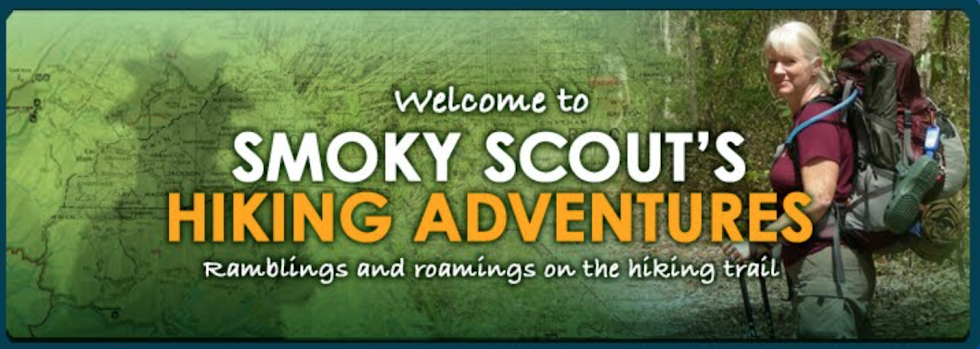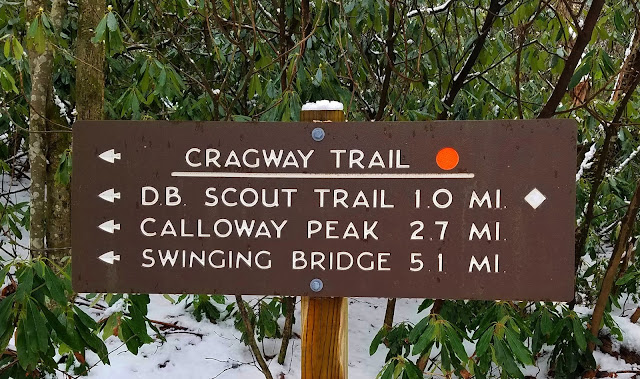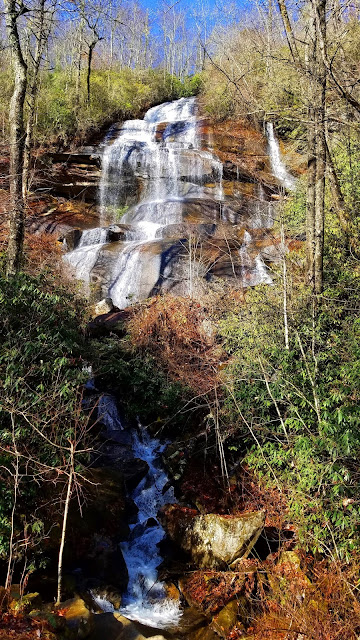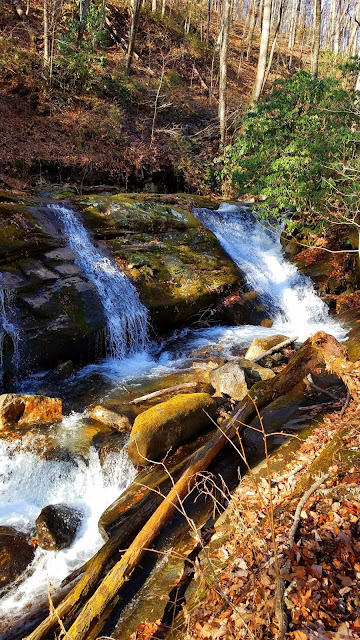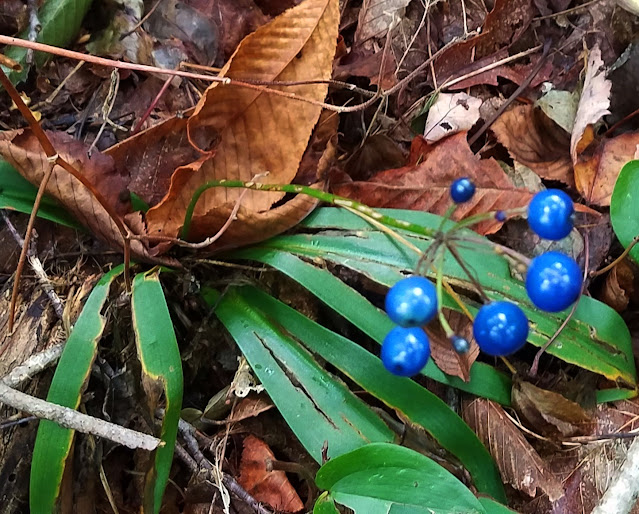Grandfather Mountain State Park: Popsicle Toes Hike to
Calloway Peak
2/1/20 – 8.3 Miles
Popsicle Toes: Every year, Rick leads this winter hike for
the Carolina Berg Wanderers. It includes
the Daniel Boone Scout Trail where I’d had an injury in June 2017, so I was
eager to revisit the scene. We were a party of five: Rick, Cathy, Mike, Jim and
me.
Jim and I drove up from Charlotte early Saturday morning. Rick advised meeting at
the Asutsi Trailhead, which is the only access to Grandfather’s east side
trails when the BRP is closed – and Rick was right. The temp at our start was in the 30’s with
snow showers predicted for the afternoon. There was already a trace on the
ground to get us pumped up, but our imagination fell far short of what awaited
high on the mountain. This would be a hike we'll talk about in our rocking chairs by the fireside.
Here you’ll find great descriptions of
the east side trails.
From the parking area, the .4-mile Asutsi Trail leads under the BRP and connects
to the Tanawha Trail, where we turned left. The trace of snow quickly became an
inch of white stuff.
Footbridge crossing Boone Fork
A quarter-mile along the Tanawha Trail we turned right onto Nuwati Trail for a
steep climb (enjoy it now because we will descend by a gentler route). I didn’t
feel winded from the effort – in fact, it felt refreshing to be outside,
bundled up and hiking on a cold day. As the snow deepened, we slowed down to be
careful with our footsteps.
Halfway up Nuwati Trail, we took a left turn onto Cragway Trail, a one-mile
connector to Daniel Boone Scout Trail. The blustery wind in exposed areas
pushed us to get back in the safety of the trees, but the elevation gain never
felt taxing: there was no hurry. The snow was now sticking to the leaves and
bare branches and I wanted to see it all.
At Flat Rock, we turned right onto Daniel Boone Scout Trail and the climbing began again with two miles to go to Calloway Peak deep in the trees now, almost no wind. My lightweight fleece was getting damp from brushing against the bushes, so I removed it and put on my red rain jacket. Fresh snow was several inches deep on the trail, covering rocks and roots. Footprints of early bird hikers led the way.
As we passed the Daniel Boone campsite I began to anticipate seeing my nemesis, the large rock surface where I had slipped and broken my shoulder on a sunny summer day…but my memory was fuzzy and everything looked different under this cotton-white blanket. Every turn in the trail was a new wonder, snow clumping on evergreen branches, clinging to the rhododendron leaves and stems of brown grasses. I gave in to the present moment.
We met the owners of the footprints as they came back down the mountain, one wearing shorts and hauling a seriously overloaded backpack (a training hike). They said the first ladder to the summit of Calloway Peak was covered in ice, so they turned back. Well, we knew that was a possibility, and we made an agreement that we would do likewise if it looked unsafe. For now, let’s continue to enjoy the day!
At 1:00 pm we stopped for a short break at Hi Balsam Shelter, a few dozen yards off trail to the left. Hi Balsam is an old 3-sided log shelter with the lowest overhang I’ve ever seen - Rick had to bend fully at the waist to duck underneath it. We ate lunch and got thoroughly chilled. We slipped crampons/snow spikes onto our boots for traction in anticipation of ever-deepening snow and hidden ice.
Do we turn around? Do we try it? Curious Cathy stepped on the first rung, then the second, and reported that they were not exactly icy. The ladder was snow-covered, but sturdy, and with slow careful steps we all climbed up, trying not to think about going back down.
The second ladder was taller and the top four rungs were leaning against dirt, covered in snow, with no way to wrap glove-covered hands around the rungs. At the top of this one, a cable was bolted to 30 feet of rock wall, to enhance that feeling of safety I did not have.
As Rick and I waited our turn on the second ladder, we were awestruck by white wrapped around every small branch, like a coating of ice but soft like snow, as though the wind had blown the snowflakes sideways. Long icicles hung down from the embankment as if they were roots of snow-covered trees growing above.
The trail continued another 100 yards, moderately steep so still claiming our attention. Suddenly we popped out onto Calloway Peak (5,964 feet). We were enveloped in a cloud, visibility just to the nearest trees, the sky a steely light blue-gray…a non-color…like nothing I had ever experienced before. The stunted evergreen trees had been dipped in white chocolate. The wind was not gale force, but stiff enough to make us shiver and quickly take photos in group combinations like a wedding party trying to get to the open bar reception.
Going back down the ladders, we took our sweet time with photos and videos, and when one would act too confident, the rest would remind us how cold it would be waiting for a rescue.
Obstacles overcome, we moved quickly on our four-mile descent, spreading out and
each moving with his or her own thoughts. Fresh snow absorbs sound, and I found
myself alone somewhere between Jim and Rick. I stopped and listened to absolute
silence.
Staying on Daniel Boone Scout Trail, we bypassed Cragway Trail. At lower
elevation the snow thinned and tree roots and rocks reappeared. We took off our
crampons. My right knee began to complain of the relentless downhill. We turned
left onto Tanawah Trail, right on Asutsi Trail, back to the parking lot.
Did we really just do that??? We'll be telling this story around the campfire for years to come.
